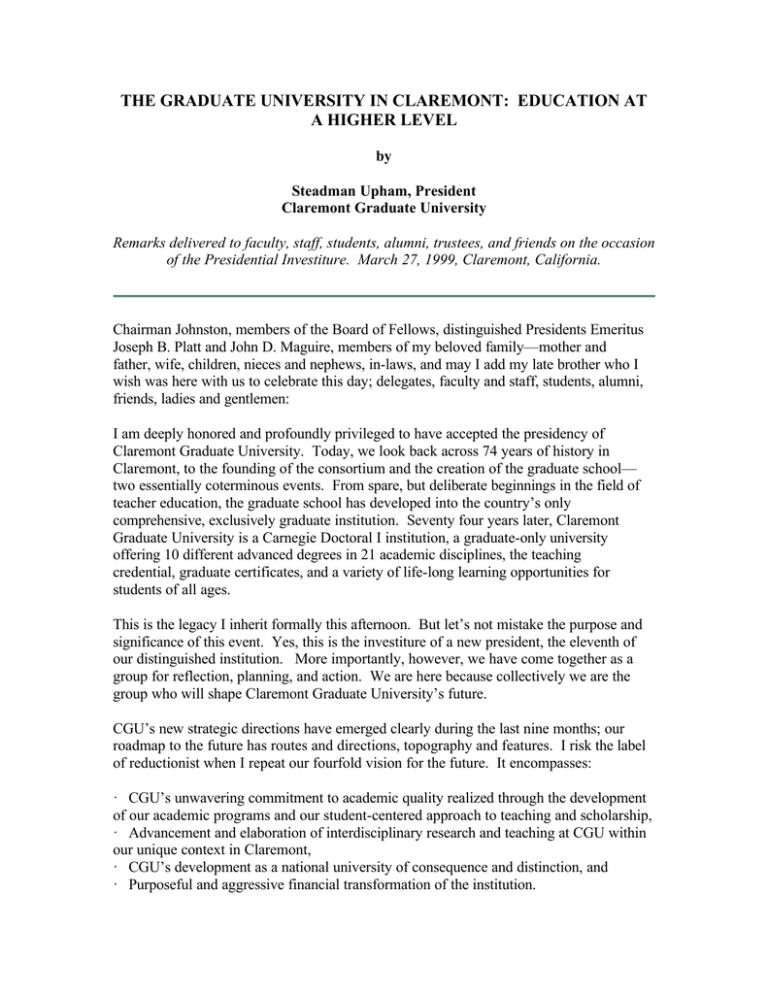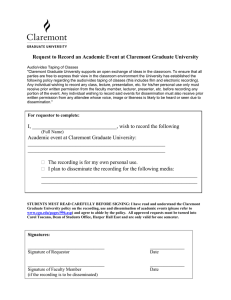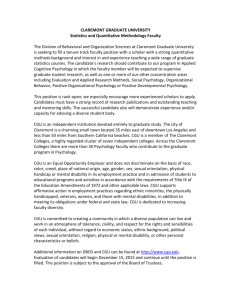THE GRADUATE UNIVERSITY IN CLAREMONT: EDUCATION AT A HIGHER LEVEL
advertisement

THE GRADUATE UNIVERSITY IN CLAREMONT: EDUCATION AT A HIGHER LEVEL by Steadman Upham, President Claremont Graduate University Remarks delivered to faculty, staff, students, alumni, trustees, and friends on the occasion of the Presidential Investiture. March 27, 1999, Claremont, California. Chairman Johnston, members of the Board of Fellows, distinguished Presidents Emeritus Joseph B. Platt and John D. Maguire, members of my beloved family—mother and father, wife, children, nieces and nephews, in-laws, and may I add my late brother who I wish was here with us to celebrate this day; delegates, faculty and staff, students, alumni, friends, ladies and gentlemen: I am deeply honored and profoundly privileged to have accepted the presidency of Claremont Graduate University. Today, we look back across 74 years of history in Claremont, to the founding of the consortium and the creation of the graduate school— two essentially coterminous events. From spare, but deliberate beginnings in the field of teacher education, the graduate school has developed into the country’s only comprehensive, exclusively graduate institution. Seventy four years later, Claremont Graduate University is a Carnegie Doctoral I institution, a graduate-only university offering 10 different advanced degrees in 21 academic disciplines, the teaching credential, graduate certificates, and a variety of life-long learning opportunities for students of all ages. This is the legacy I inherit formally this afternoon. But let’s not mistake the purpose and significance of this event. Yes, this is the investiture of a new president, the eleventh of our distinguished institution. More importantly, however, we have come together as a group for reflection, planning, and action. We are here because collectively we are the group who will shape Claremont Graduate University’s future. CGU’s new strategic directions have emerged clearly during the last nine months; our roadmap to the future has routes and directions, topography and features. I risk the label of reductionist when I repeat our fourfold vision for the future. It encompasses: · CGU’s unwavering commitment to academic quality realized through the development of our academic programs and our student-centered approach to teaching and scholarship, · Advancement and elaboration of interdisciplinary research and teaching at CGU within our unique context in Claremont, · CGU’s development as a national university of consequence and distinction, and · Purposeful and aggressive financial transformation of the institution. We know where we are going, although we continue to search for the best possible route, the ideal speed of travel, and the means to support our journey. This "taking of bearings" will be a constant activity in the years ahead, as will be the refinement of our four strategic objectives. This is day to celebrate Claremont Graduate University’s past and future. Let me begin by reflecting on our remarkable accomplishments. During the last 74 years, CGU has conferred nearly 16,000 graduate degrees, making it one of the leading contributors to advanced education and knowledge creation in the country. Only a dozen or so of the oldest research universities can match this achievement over this same period of time. More important, however, is the fact that our alumni are among the most distinguished of any such group in the world. We count among our alumni: · · · · · · 28 college presidents CEOs and leading business executives in every sector of the economy federal and state legislators senior government officials and diplomats award winning writers and artists, and distinguished academics Three of our graduates have received MacArthur "genius" grants. Many others have received national grants and awards in recognition of their excellence and accomplishments. Our current students continue this distinguished tradition. We count among us the president of the National Association of Black Graduate Students, recipients of Fulbright Fellowships, national research awards, and prestigious merit-based scholarships. Our faculty have received many awards for scholarly excellence, including Pulitzers Prizes, Guggenheim Fellowships, and grants for research from the great national foundations. We claim as our own one of the most extraordinary thinkers and social philosophers of our time, Peter F. Drucker. Professor Drucker’s teachings, writings, thought, and commitment to the liberal arts pervade our entire institution, leaving a permanent legacy of interdisciplinary scholarship and intellectual innovation for future generations of faculty and students at Claremont Graduate University. His dictum "solve the future" remains our call to action. Claremont Graduate University’s affiliated institutes are another mark of our distinction and accomplishments. The research that flows from these units garners national media attention and contributes to policy-making at local, state, and federal levels. These partnerships add breadth and depth to our academic programs and provide unparalleled academic opportunities for our students. CGU’s Board of Fellows and the several Boards of Visitors of the schools and centers are comprised of individuals who have reached the highest levels of accomplishment in their chosen professions, people who have defined themselves by the power of their vision and the scope and impact of their achievements. More importantly, however, our board members are distinguished by their values and ethics; by their personal sense of devotion to cause, ideals, and purpose; and by their extraordinary generosity. I want to acknowledge publicly the many contributions of these individuals to the life and health of Claremont Graduate University. We are proud and privileged to have you in our midst. Our students, our faculty, our institutes, and our boards define our history and current context. Needless to say, we are truly blessed by the abundance of our talents. What, then, of our future? How do we nurture our genius, maintain our focus and energy, and follow our vision as we enter a new millennium? Our collective progress of the last nine months has been measured but rapid, focused but substantial. We have added several new faces to CGU’s senior leadership team; several truly distinguished faculty members have joined our ranks; we have restructured CGU’s office of academic affairs; and we continue to reengineer administrative processes to improve our efficiency, productivity and service. We are redesigning our financial systems to provide better fiscal control, budget analysis, and forecasting for CGU’s centers and schools; we seek financial transformation through cornerstone gifts to endowment; we are engaged and determined to strengthen interdisciplinary teaching and scholarship in every academic program. Our commitment to interdisciplinary teaching, research, and civic engagement is being carried forward in new degree programs like the Master of Arts in Politics, Economics, and Business, Master of Arts in Applied Women’s Studies, Master of Science in Financial Engineering, Master of Arts in Community Education and Teaching, and the Master of Arts in Interdisciplinary Studies. We are aggressively pursuing opportunities to develop our academic programs and extend their reach. We are expanding the Department of Information Science over a three-year period into a School of Information Science. Our outreach through the newly created Division of Extended Learning will enlarge the number and types of courses, workshops, and institutes offered during the summer, and will create for the first time a year-round academic capacity at CGU directed to life-long learning. We have launched a marketing initiative to raise the visibility and highlight the attractiveness of CGU’s outstanding academic programs. Our aim this year is to recruit even more accomplished students and to make sure that all of our academic programs meet their enrollment targets. Next year, resources permitting, we will carry a directed and highly focused marketing campaign forward to promote the teaching and research of the faculty and the ideas that fuel the University. Our long-term goal is to raise significantly the national profile of Claremont Graduate University and its people. We are working to create a much more stable financial base for CGU. The key to this goal is to complete the Campaign for Endowment. Student fellowships and cornerstone endowments for the schools and centers remain our top priorities for endowment gifts. I’m pleased that each of these initiatives has begun with great energy and enthusiasm, and that we remain very much on course. Our broader vision for Claremont Graduate University, however, is even more energetic. First and most importantly, we seek a wider and more accommodating place for graduate education in Claremont. This notion of a place for graduate education leads me to what we are calling the Blaisdell Challenge, and to our aspirations for academic cooperation with the undergraduate Claremont colleges. During the last nine months, I have had many conversations with faculty, staff, Board members, colleague presidents, deans of faculty, and friends about the importance of the Blaisdell Challenge. Provost Hart and Vice President Macaulay, along with dozens of CGU faculty have joined these conversations. Together we are carrying the message of academic cooperation and our strategic vision for graduate education into the broader academic community of Claremont. The message of the Blaisdell Challenge is simple but powerful. We seek: · Regular faculty exchanges between CGU and the five undergraduate colleges. Faculty exchanges are the glue of academic cooperation and the centerpiece of the Blaisdell Challenge. I’m pleased to note that CGU received in January a $5,000,000 gift to endowment from an "admirer of James Blaisdell" that will underwrite completely this aspect the initiative. More importantly, however, CGU wants to become an academic partner of the undergraduate colleges in teaching and knowledge creation. Seeding and facilitating academic cooperation will produce in Claremont even more interesting and rigorous intellectual environments for students and faculty. · Graduate student fellowships. Graduate students are the engines of innovation in higher education and a substantial academic resource. The most talented and advanced of our students deserve the opportunity to gain teaching experience in the best instructional environments we have to offer. Such environments exist throughout The Claremont Colleges. Our goal is to develop and fund graduate fellowships so that undergraduate faculty have access to this substantial talent pool. · Baccalaureate-master’s programs in selected academic disciplines. BaccalaureateMaster’s programs integrate the various curricula of The Claremont Colleges and foster academic cooperation among faculties. Our goal is to have robust and effective baccalaureate-master’s programs with all of the undergraduate colleges in each of the disciplines we offer. · Disciplinary and interdisciplinary field committees. In Oxford, responsibility for degree and diploma courses lies with the teachers of the various subjects, who are organized as members of different faculties. An elected faculty board administers each such faculty. Claremont’s reflection of this structure is the field committee. Field committees are intellectual meeting places for our faculties, and should stimulate collaborative research and teaching. Our goal is to have vital, dynamic, and active field committees in each of our major subject areas. These four elements of the Blaisdell Challenge will solidify the place of graduate education in Claremont, and will create durable and meaningful academic linkages to selected programs in the undergraduate Claremont Colleges. We have an ambitious remaining fundraising goal of $15,000,000 in endowment for this initiative, and with your support and assistance, we shall complete this campaign within the next few years. However, simply raising money will not create the rich intellectual environment I envision for Claremont Graduate University. We must also raise consciousness about the value, impact, and importance of graduate education. We must work hard to erase the notion that graduate education continues as a central service in Claremont. Our corporate separation from Claremont University Center will help in this regard, but it is incumbent upon us—CGU faculty and staff—to demonstrate in the years ahead that CGU is deserving of academic respect, institutional independence, corporate autonomy, and the 74 years of accomplishment in the consortium to which we lay claim. Such a demonstration must be based on the merits of our performance and the significance of our contributions. Undergraduate education in Claremont is very highly developed. Indeed, five of the very best undergraduate colleges in the world are our neighbors and partners, and we salute their stunning accomplishments. In fact, their preeminence and stature raise the bar for us, and create a disparity in status that we must address. At this time in our history, we must recognize and accept the fact that graduate education in Claremont is not well understood beyond the walls of our own institution. Erasing this disjunction in recognition and reputation between graduate and undergraduate, is one of our greatest challenges in the years ahead. To begin, we must raise consciousness in Claremont through our actions and performance about what we do as teachers and scholars. We must make sure that CGU’s graduate programs are rigorous and demanding—true intellectual beacons both in Claremont and beyond. Working toward this goal gives meaning and life to the motto on our institutional seal, Multa Lumina, Una Lux, Many Lamps, One Light. This process will require all of our skills as teachers. I believe that we must begin by carefully explaining our expectations for the performance of graduate faculty. First, our teaching responsibilities are different from those of the other Claremont Colleges. We are graduate student-centered; our teaching schedules are established in recognition of extensive faculty service on graduate committees. We expect each and every CGU faculty member to be deeply involved in the mentoring of graduate students and fully committed to the supervision of research and practice. Such activities are intensely timeconsuming, but also intensely rewarding. The deep and intense interaction between student and professor is the essential quality that distinguishes graduate from undergraduate education. As Provost Hart has so aptly stated, "Graduate education is focused and expert, not broad and general." Graduate teaching and mentoring are materially different than working with undergraduates—not better, but fundamentally different. As we advance as an institution, it is our responsibility to demonstrate why our teaching policies make sense. I believe that our academic model requires these conditions, which we celebrate and nurture. Our academic model also requires faculty to maintain active research programs that contribute to the creation of knowledge. Consequently, graduate faculty must have time for research and creative activity. In fields where it is possible, CGU also expects grant getting by faculty to initiate and support research. These conditions are absolute requirements for exceptional graduate faculty. We have a one-in-six term sabbatical leave policy to support our demanding expectations in this area, a policy that is generous and expensive. Yet it is also fundamental for faculty productivity at the graduate level. Again, it is our responsibility to demonstrate through our accomplishments and performance to our academic colleagues in Claremont why this policy is essential to our model of education. The depth and breadth of our scholarly output, the quality of our teaching, the impact of our interaction with students, and the effectiveness of our practice must leave no doubt about why we operate in this manner. Let me close my remarks this afternoon by focusing on both past and future. The development of the Group Plan in Claremont and the simultaneous founding of the graduate school in 1925 were borne of the same necessity in Pomona College. Unprecedented growth in California led to pressure from Pomona alumni and local citizens to provide more educational services—graduate and undergraduate—to the burgeoning population. Yet Pomona College did not want to follow the road taken by other schools and become a large, undifferentiated university. Instead, Pomona’s overwhelming desire to remain a small college gave rise to the founding of what Mr. Blaisdell identified as "a group of institutions divided into small colleges—somewhat on the Oxford type—around a library and other utilities which they would use in common." With this model of higher education, Mr. Blaisdell hoped to preserve the "inestimable personal values of a small college, while securing the facilities of a great university." Mr. Blaisdell, if you’re listening, I’m pleased to say that the physical reality of your vision for Claremont has been created. Five small undergraduate colleges, a graduate university, and a specialized institute are now bound together through the central programs and services of a university center. Together, we each preserve the intimate learning environment of a small college, while collectively we provide the resources of a great university. And of course, the dream of founding new academic institutions in Claremont remains very much alive. We are, however, only partly done building from the blueprint you have given us. Our physical plant and administrative structure are the facade of the Group Plan. Behind this facade lies a deeper structure embedded in the world of ideas. The world of ideas connects scholars and academic disciplines in Claremont and, as Claremont’s graduate university, CGU must be the leader in making these connections. This exacting assignment is the most dynamic and exciting part of Mr. Blaisdell’s challenge. It is also the strategic intellectual difference for Claremont, the condition in the future that will attract to us the most accomplished faculty, the most able and prepared students, the most loyal and dedicated trustees, the largest and most diverse assembly of friends, the resources we require to advance. This afternoon I ask every Claremont Graduate University faculty member to embrace Mr. Blaisdell’s challenge and become accountable in your discipline for the world of ideas in Claremont. I ask that you connect with your colleagues in the Claremont colleges and set about the business of forging durable, stable, and enduring academic partnerships. Graduate faculty must assume roles as intellectual leaders, and graduate programs must define the leading edge of scholarship in the disciplines we represent. To require less of our programs and ourselves abrogates the broader claim we make for the place of graduate education in the academy. Intellectual interconnectivity is the essence of the Blaisdell Challenge. The rest is merely structure and edifice. In the years ahead, we must pursue academic cooperation across the disciplines as one of our primary objectives in Claremont. In a community of scholars, intellectually weak or friable academic partnerships are not acceptable because they truncate and enfeeble the world of ideas. This is our work and Claremont Graduate University’s path to greatness. I am pleased to be a part of it, and I look forward with great enthusiasm and anticipation to leading you as we make this vision our reality.


